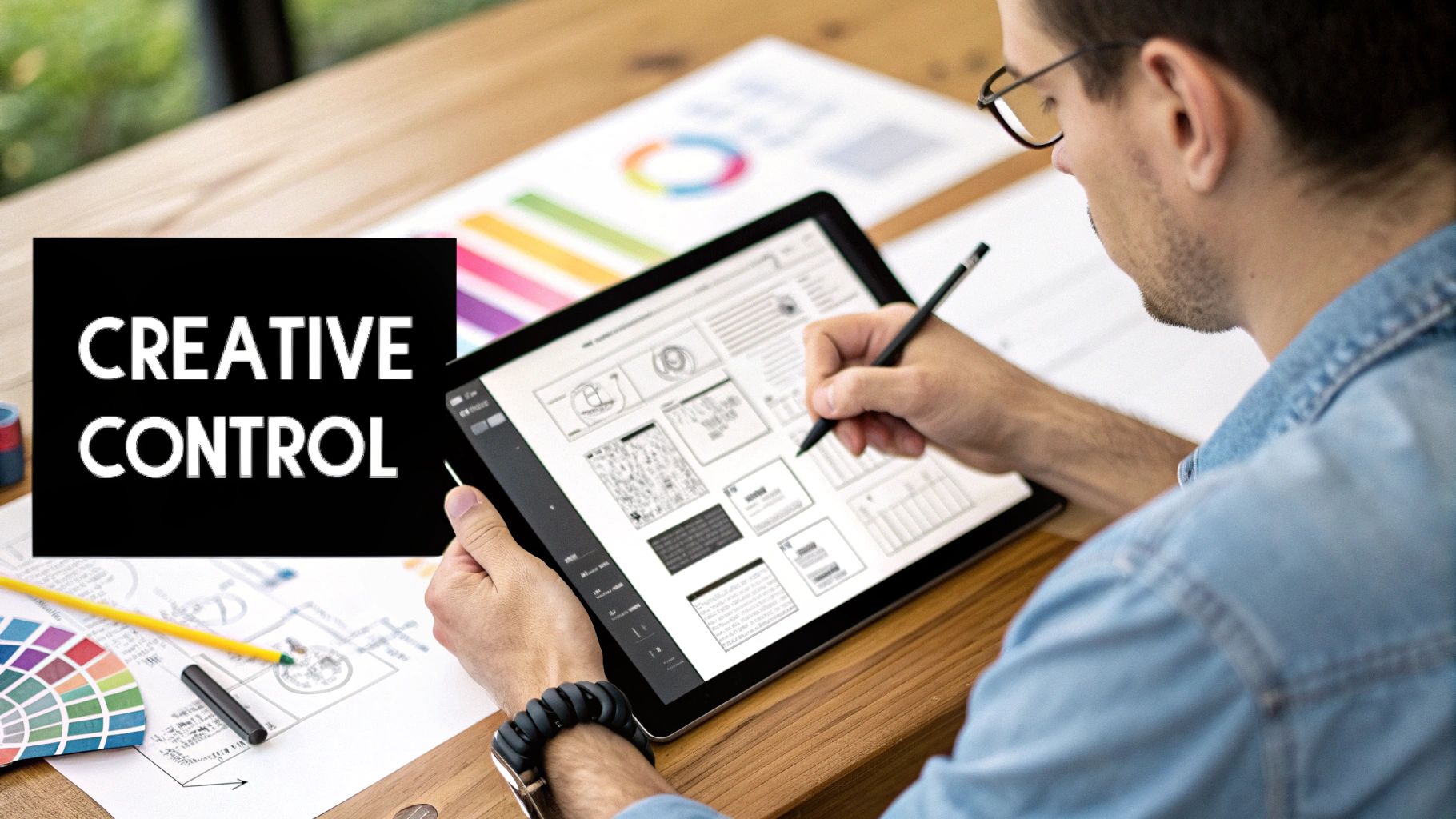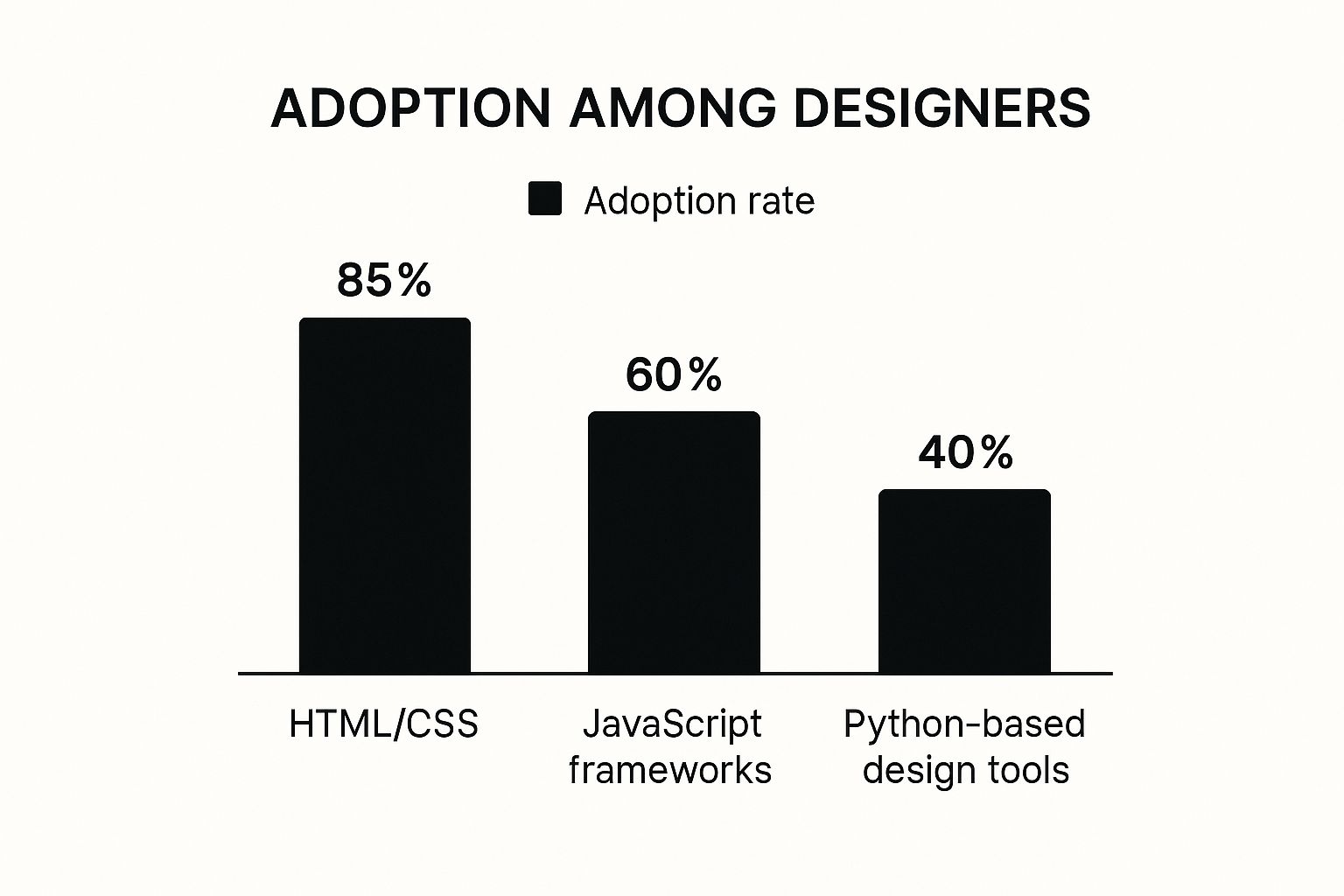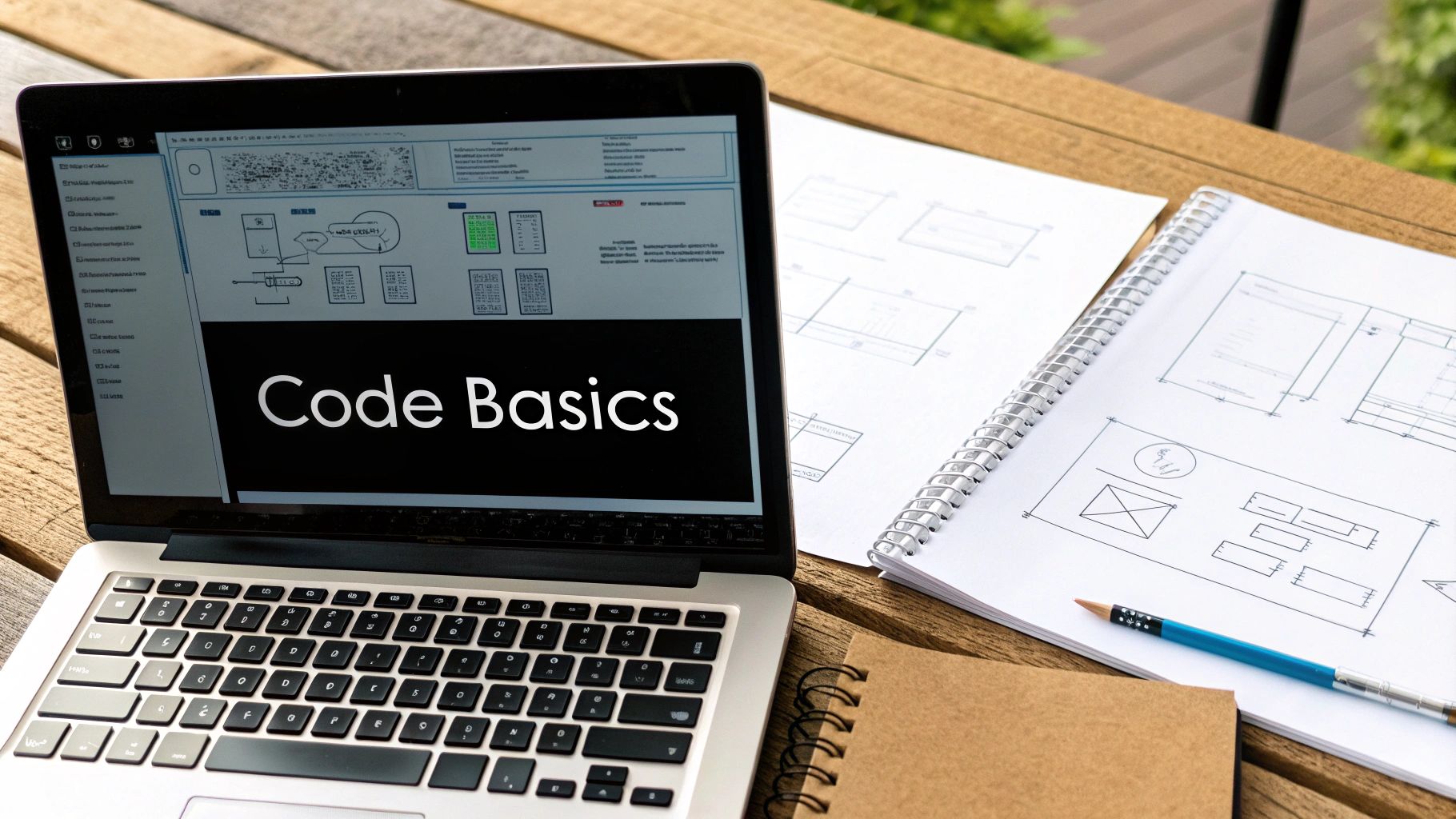So, what does it actually mean when we talk about designers learning to code?
We're talking about designers getting their hands dirty with the foundational languages of the web—primarily HTML, CSS, and JavaScript. This isn’t a career change into full-stack development. It’s about understanding the raw materials you’re shaping every single day.
Why Coding Is a Designer's New Superpower
Imagine a film director who has no idea how cameras work, or a sculptor who doesn’t understand the properties of clay. They might have a brilliant vision, but bringing it to life will be a constant struggle. Designers who don’t grasp the basics of code are in a similar spot; they're drawing up beautiful blueprints without really knowing the construction materials.
This is where a little bit of code knowledge becomes more than just a technical skill—it's a creative unlock. It gives you the power to break free from static, lifeless mockups and build interactive prototypes that actually feel real.
You can test out animations, fine-tune transitions, and nail down user interactions with genuine fidelity. This direct translation from concept to reality is a total game-changer, ensuring the experience you envisioned is the one users get.
Gaining Control and Improving Collaboration
When you understand the code behind your designs, your entire relationship with developers changes for the better. Instead of just handing off a static image and hoping for the best, you can have real, meaningful conversations about what’s possible.
This shared language makes everything smoother:
- Fewer Revisions: You start designing with technical constraints in mind, which means less back-and-forth later.
- Faster Handoffs: The assets and specs you provide are immediately useful to your dev team.
- Better End Products: True collaboration ensures the final product doesn't lose the soul of your original design.
Ultimately, learning to code gives you agency. It puts you in the driver's seat, allowing you to ensure the final product aligns perfectly with your design intent and elevates the overall user experience.
By bridging this gap, you don't just streamline the development process. You deepen your own understanding of what makes a digital product truly great. It’s a core principle you can explore further by learning more about what user experience design truly entails. It’s all about building that holistic perspective, from the first sketch to the last line of code.
Bridging the Gap Between Design and Development

We’ve all seen it: the classic wall between design and development. It’s where good ideas meet friction, handoffs get messy, and the final product just doesn't quite hit the mark. But what if that wall could become a bridge?
When designers start to speak the language of code, that’s exactly what happens. It creates a genuinely collaborative space where creative vision and technical execution are perfectly in sync. It all starts when you stop seeing a layout as a static picture and start seeing it for what it is—a collection of components, constraints, and interactive states. That’s how a developer sees it, and that shared perspective is the secret to creating designs that are not only beautiful but also practical and efficient to build.
Adopting a Developer Mindset
One of the first concepts to really wrap your head around is the Box Model. It’s the fundamental rule that governs every single layout on the web. Just imagine every element on a page—a button, an image, a chunk of text—as being tucked inside its own invisible box. That box has properties like padding (the space inside), margin (the space outside), and a border.
Once you get this, the way you design changes. You’ll instinctively create more consistent spacing and build layouts that are just plain logical. A developer can look at your work and immediately understand how to translate it into CSS. You're no longer just guessing pixel values; you're defining the relationships between elements. And when designers understand these core processes, they can help improve developer productivity across the board.
By internalizing core web principles, a designer can preemptively solve development challenges during the creative phase, leading to dramatically fewer revision cycles and a more polished final product.
The same goes for responsive principles. You move beyond creating separate mockups for desktop, tablet, and mobile. Instead, you start thinking about how components should reflow and adapt to any screen size. This proactive approach ensures a seamless user experience everywhere, which is non-negotiable in a world where performance and adaptability are everything.
The Real-World Impact of a Shared Language
The benefits of speaking the same language aren’t just theoretical; they’re tangible and you’ll feel them almost immediately. When your design decisions are grounded in technical reality, the entire product lifecycle gets smoother.
Let’s look at the numbers. First impressions are 94% design-based, and a whopping 75% of users judge a website’s credibility on its design. At the same time, just a one-second delay in page load time can tank conversions by over 4.42%. Performance is deeply, deeply tied to design choices.
A designer who gets this can make smarter calls about everything from image optimization and font loading to complex animations. This knowledge is incredibly powerful, especially when building a source of truth for your team, something we dig into in our guide on effective design system documentation. When design and code are truly in sync, the result is a product that’s not just beautiful and trustworthy, but one that actually performs.
Your Toolkit for Coding in a Design World
Dipping your toes into code doesn't mean you have to become a full-stack developer overnight. The real goal is to be strategic. Think of it like an artist learning about their canvases and pigments—you don’t need to manufacture the paint, but knowing how it behaves is what elevates your craft. It’s all about understanding the medium you’re actually designing for.
Your journey starts with the two non-negotiable building blocks of the web.
-
HTML (HyperText Markup Language): This is the skeleton of every single webpage. If you imagine a website as a house, HTML is the blueprint and the wooden frame. It lays out all the core elements—the headings, paragraphs, images, and buttons—giving your content a logical structure.
-
CSS (Cascading Style Sheets): If HTML is the frame, CSS is the interior designer. It’s the language that controls everything visual: the colors, fonts, spacing, and layout. CSS is how you transform that raw HTML skeleton into something beautiful, branded, and intuitive to use.
Getting a solid handle on these two is the most direct way to see your static mockups come to life as real, breathing web experiences.
Bringing Your Designs to Life with Interactivity
Once you’ve got the structure and style locked down, it’s time to add a pulse to your designs. That's where JavaScript comes in.
JavaScript is the language of interactivity. It handles everything from simple button clicks and form validations to complex animations and fetching data from a server. You don't need to be a JavaScript wizard, but understanding its role is what allows you to design dynamic experiences that feel modern and truly engaging.
As more designers embrace these core technologies, some interesting patterns have emerged.

This data really shows that while foundational languages like HTML and CSS are nearly universal for designers who code, the more specialized tools come into play as projects get more complex.
Modern Platforms That Blur the Lines
Beyond the classic code editor, a new breed of powerful platforms has popped up, effectively creating a bridge between visual design and functional code. These tools are total game-changers for designers who want to build high-fidelity, production-ready sites without living in a code editor 24/7.
These platforms don't replace the need to understand web fundamentals. Instead, they give you a visual interface to apply your knowledge of structure (HTML) and style (CSS), supercharging the entire workflow from concept to launch.
Take tools like Webflow and Framer, for example. They let you design with real web components, translating your visual decisions into clean, semantic code on the fly. This creates an incredible feedback loop where you can design, build, and test in a live environment. When you're prototyping or trying to get feedback, this workflow is worth its weight in gold—a topic we dig into in our roundup of the top design feedback tools.
Choosing Your Design-to-Code Tool
With so many options out there, picking the right platform can feel a bit overwhelming. The best choice really depends on what you're trying to build, from a simple portfolio to a complex interactive website.
| Tool | Primary Use Case | Learning Curve | Key Feature for Designers |
|---|---|---|---|
| Figma | Interactive prototyping & design handoff. | Low | Its prototyping features are best-in-class for simulating user flows without code. |
| Webflow | Building production-ready, dynamic websites visually. | Medium | The visual CSS grid and flexbox controls are incredibly powerful and intuitive. |
| Framer | High-fidelity prototyping and building React-based sites. | Medium-High | Seamlessly transitions from design canvas to live, interactive React components. |
| Storybook | Developing and documenting UI components in isolation. | High | A "living style guide" that lets designers and devs test components independently. |
Ultimately, each of these tools offers a unique way to bridge the gap between your design vision and a coded reality. The key is to find the one that best fits your personal workflow and the complexity of your projects.
The Rise of Low-Code and No-Code Platforms

The traditional walls between design and development are coming down. A huge part of that is the explosion of low-code and no-code platforms. These tools are completely changing the game, putting the power to build and ship fully functional websites right into the hands of designers—often without writing a single line of code.
Think of a platform like Webflow as a visual layer on top of code. Instead of wrestling with HTML and CSS in a text editor, you’re dragging, dropping, and styling elements on a canvas. Behind the scenes, the platform translates every move you make into clean, production-ready code. This opens up a powerful new way of working where designers can build, test, and tweak live products on the fly.
This kind of direct control means you can perfect that tricky animation, nail down responsive behaviors, and even manage a CMS without ever having to ping a developer. The feedback loop shrinks from days or weeks down to mere minutes. It’s a level of agility that just wasn't possible before.
A Fundamental Shift in Product Creation
Let's be clear: this isn't just a trend. It’s a real evolution in how we build things for the web. The market for these platforms is blowing up because they solve a massive business problem: the need to get things built faster and more efficiently.
Low-code platforms empower what some call "citizen developers"—often designers or product managers—to take a hands-on role in development, pushing ideas from a Figma file to a live site with incredible speed.
The numbers back this up, and they’re staggering. It’s projected that by 2026, a mind-blowing 75% of all new applications will be built using low-code platforms. These tools can speed up development by as much as 90% and cut costs by around 70%. It’s no wonder that 81% of companies now see them as strategically vital. You can dig deeper into these figures by checking out these insights on low-code adoption.
Empowering Designers to Build and Own
So, what does all this mean for you—the designer who’s learning to code? It means your grasp of web fundamentals like the box model, responsive layouts, and semantic HTML is more valuable than ever.
These platforms aren't magic wands; they're visual abstractions of the code you've been learning. A designer who truly understands what’s happening under the hood will be miles ahead, creating designs that aren't just pretty but are also performant, accessible, and scalable.
Low-code tools give you the perfect middle ground. You get to apply your technical know-how in a visual, intuitive environment. This empowers you to:
- Launch your own projects, from a personal portfolio to a full-blown client website.
- Build high-fidelity prototypes that feel so real, they’re basically the final product.
- Free up engineering resources to tackle the really complex, backend challenges.
At the end of the day, these platforms are closing the final gap between vision and execution, putting more creative and technical power directly where it belongs: in the hands of the designer.
How AI Is Accelerating the Design-to-Code Workflow
Let’s be honest, the gap between a beautiful design and functional code has always been a bit of a bottleneck. But that’s changing, fast. Artificial Intelligence is stepping in and completely reshaping how we get from A to B, and it’s about much more than just generating cool images. AI is becoming a genuine collaborator in the development pipeline, taking what was once a multi-day process and shrinking it down to hours.
You can see this happening in real-time with AI coding assistants. Tools like GitHub Copilot are like having an experienced developer sitting next to you, ready to jump in. Imagine you’ve just finished a component in Figma. Instead of starting from scratch, you can just write a quick comment describing what you need, and the AI will spit out the HTML and CSS for you. It’s a massive time-saver, especially for rapid prototyping and getting ideas off the ground.
From Automation to Intelligent Implementation
The real magic of AI in the design workflow is its knack for handling the tedious, repetitive stuff. Nobody enjoys writing boilerplate code for the tenth button or navigation bar. AI tools can generate these elements in a heartbeat, which frees you up to focus on the bigger, more creative challenges.
And it’s not just about cranking out code faster—it’s about doing it with precision. Some tools can now scan a design file and produce code that’s shockingly accurate to the original layout, spacing, and styling. This seriously cuts down on the back-and-forth and visual bugs that pop up during a manual handoff. It ensures the final product actually looks like the design you poured your heart into. Of course, AI isn't the only way; it's always smart to explore broader strategies to automate repetitive tasks to make your whole process smoother.
AI isn’t here to replace designers or developers. Think of it as a force multiplier. It’s augmenting our skills, letting smaller teams—or even solo creators—build incredibly sophisticated products faster than we ever thought possible.
The numbers back this up. AI-generated code now makes up about 41% of all new code written globally. In the U.S., a staggering 92% of developers are already using AI-assisted tools in their daily work. Some startups are even launching with codebases that are up to 95% AI-generated. That’s a powerful testament to how much it’s compressing development cycles. You can dive deeper into these trends and discover insights on AI's role in coding at elitebrains.com.
Ultimately, this integration gives designers more power to bring their ideas to life with less friction. With AI as a partner, that gap between a creative vision and a live, interactive product gets smaller and easier to cross every day.
A Practical Workflow From Design to Prototype

This is where the magic really happens—when your static design file transforms into a living, breathing prototype. Learning to code changes your workflow from a simple, linear handoff to a dynamic loop of creation and refinement.
That cycle—design, build, test, repeat—is what separates a good digital experience from a great one. It's how you build products that are not just beautiful but genuinely intuitive and technically solid.
The journey still starts where you’re most comfortable, probably inside a tool like Figma. But now, you’re designing with development in mind from the very first click. You’re using features like auto-layout to dictate how elements should respond on different screens and building out a library of reusable components.
When you structure your designs this way, you're already starting to speak a developer’s language.
Translating Vision into Reality
The next step is turning that well-structured design into a high-fidelity prototype that people can actually click, tap, and interact with. This is where your coding know-how becomes your superpower.
Whether you're using a visual development tool like Framer or just dabbling in some basic HTML and CSS, you’re building a tangible version of your vision. This is a world away from a simple clickable mockup.
An interactive prototype lets you truly test:
- Microinteractions: What does that button feel like when you hover over it?
- Animations and Transitions: Are the page transitions smooth, or do they feel clunky?
- Real Data: How does the layout hold up when you plug in actual user content instead of "Lorem Ipsum"?
Building an interactive prototype isn't just another step to check off. It’s a powerful communication tool. It gets you concrete, honest feedback from stakeholders and users early on, making sure the final product is exactly what everyone hoped for.
This hands-on cycle of building and testing gives you invaluable insights that you can feed right back into your design. It's an iterative process that dramatically boosts the quality of your work.
Ultimately, this workflow means you’re delivering assets that are truly production-ready, closing the gap between creative vision and coded reality. For a deeper dive into each stage, check out our guide to the essential design process steps.
Common Questions About Coding for Design
Dipping your toes into the world of coding can feel like a huge step, and it’s bound to bring up some questions. It's a serious skill to add to your toolkit, so let's clear up a few of the most common uncertainties designers face right at the start.
Getting these points sorted out can give you the confidence to jump in. Remember, the goal isn't to switch careers—it's to become a more capable and well-rounded designer.
Do I Need to Become a Full-Time Developer?
Absolutely not. That’s a common misconception. Think of learning to code not as a career change, but as a way to supercharge your design skills. You only need to get comfortable with some HTML, CSS, and maybe a little JavaScript to really understand the medium you're designing for.
It’s like an architect who understands the properties of concrete. They don't need to pour the foundation themselves, but knowing the material’s limits and possibilities is essential to designing a solid, beautiful building.
This knowledge simply gives you the power to create more practical designs, build prototypes that feel real, and have much smarter conversations with your development team.
What Is the Best First Language for a Designer to Learn?
Start with HTML and CSS. No question. These two are the absolute bedrock of the web, and they’re the most direct way to see your visual ideas come to life.
- HTML is the skeleton. It gives your webpage its core structure.
- CSS is the skin and clothes. It handles all the styling—colors, fonts, layout, everything that makes it look good.
Getting a good handle on these two gives you immediate, tangible power. Once you feel solid there, adding some JavaScript for interactivity is the perfect next move. And of course, a strong design foundation is key. If you need a refresher, you can brush up on the essentials with our breakdown of graphic design terminology.
How Do Tools Like Webflow or Framer Fit In?
This is where things get really exciting. Platforms like Webflow and Framer are the perfect bridge between design and code. They are powerful visual tools that write clean code behind the scenes as you design, letting you build real, production-quality websites without ever having to live in a code editor.
But here’s the thing: to really get the most out of them, you still need to understand core web concepts like the box model, positioning, and how responsive design works. This is exactly why that foundational knowledge of HTML and CSS makes you so much more effective when you start using these advanced tools.
Ready to connect with talented professionals who can bring your vision to life? Find the perfect creative partner on Creativize and start building your next great project today. Visit us at https://creativize.net.

